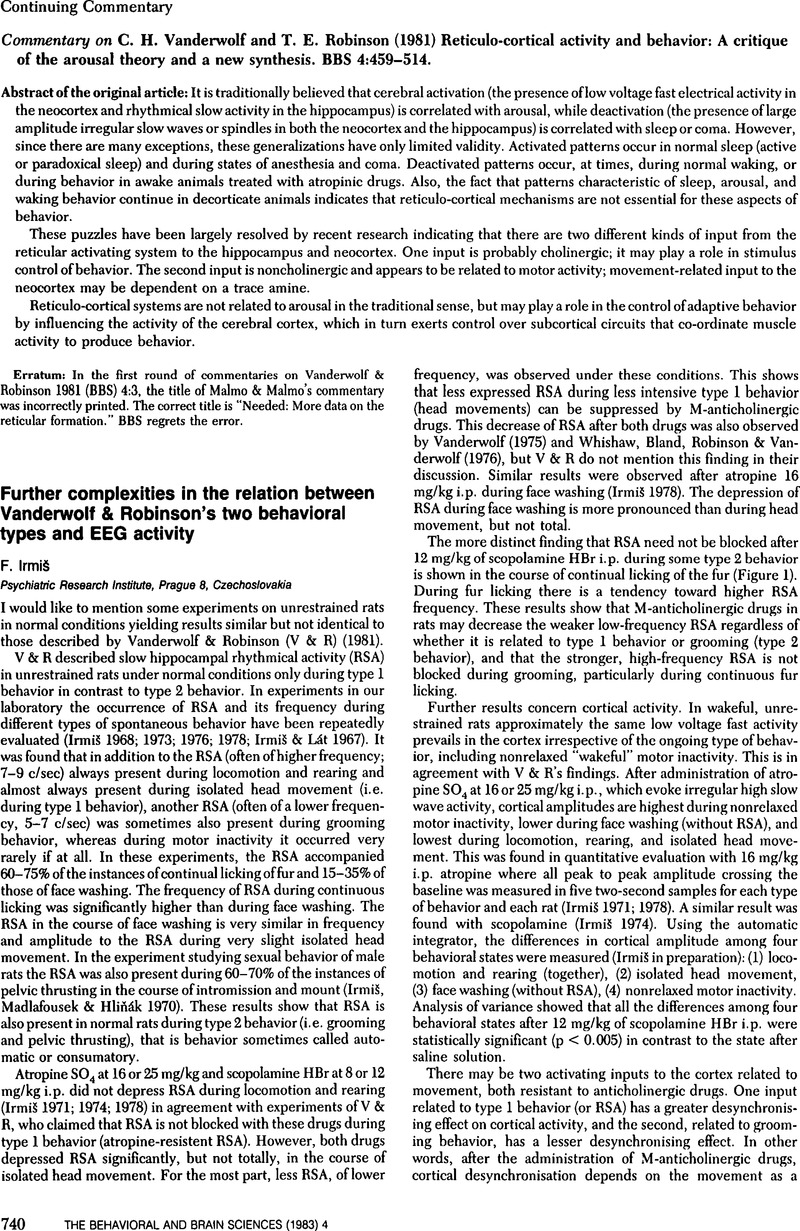No CrossRef data available.
Article contents
Brain-behavioral studies: The importance of detailed observations of behavior
Published online by Cambridge University Press: 04 February 2010
Abstract
An abstract is not available for this content so a preview has been provided. Please use the Get access link above for information on how to access this content.

- Type
- Continuing Commentary
- Information
- Copyright
- Copyright © Cambridge University Press 1983
References
Irmiš, F. (1968) On the question of relation between individual differences in EEC activity and in spontaneous behavior of rats (in Czech: K otázce vztahu mezi individuálními rozdíly v EEC aktivitě a v spontánním chování krys). Thesis, Prague. [FI]Google Scholar
Irmiš, F. (1971) ‘Dissociation” between EEC and spontaneous behaviour of rats after atropine. Acticitas Nervosa Superior (Prague) 13:217–18. [FI]Google Scholar
Irmiš, F. (1973) Quantitative analysis of relationship between behavioural, electrocortical and hippocampal “activation” in rats. Activitas Nervosa Superior (Prague) 15:7–8. [FI]Google Scholar
Irmiš, F. (1974) Effects of scopolamine on the EEC of cortex and hippocampus during spontaneous behaviour in rats. Activitas Nervosa Superior (Prague) 16:220–22. [FI]Google Scholar
Irmiš, F. (1976) Hippocampal rhythmical slow (“theta”) activity in relation to certain muscle movement. Elect roencephalography and Clinical Neurophysiology 41:553. [FI]Google Scholar
Irmiš, F. (1978) To the question of two activating mechanisms: Cortical EEC desynchronisation and hippocampal “theta” rhytism. Activitas Nervosa Superior (Prague) 20:22–25. [FI]Google Scholar
Irmi&, & Lát, J. (1967) Correlation between EEC activity in hippocampus and behaviour of rats (in Czech: korelace mezi EEC aktivitou v hippocampu a chováním u krys). Ĉeskoslovenská Fysiologie 16:236–37. [FI]Google Scholar
lrmi, & Hliňák, Z. (1970) Hippocampal electrical activity in course of sexual behaviour of male rats. Physiologia Boheinoslovaca 19:33–87. [FI]Google Scholar
Leung, L. S., Harvey, G. C. & Vanderwolf, C. H. (1982) Combined video and computer analysis of the relation between the interhemispheric response and behavior. Behavioural Brain Research 6:195–200. [CHV]CrossRefGoogle Scholar
Leung, L. S., Lopes, da Silva F. H. & Wadman, W. J. (1982) Spectral characteristics of the hippocampal EEC in the freely moving rat. Electroencephalography and Clinical Neurophysiology 54:203–19. [CHV]CrossRefGoogle Scholar
Peterson, B. W. (1979) Reticulo-motor pathways: Their conisections and possible roles in motor behavior. In: Integration in the nervous system, ed. Asanuma, H. & Wilson, V. J., pp. 185–204. lgaku-shoin. ]JMS]Google Scholar
Robinson, T. E. & Therrien, B. A. (1982) Does hippocampal theta tell us anything about the neuropsychology of anxiety? Behavioral and Brain Sciences 5:500–502. [CHV]CrossRefGoogle Scholar
Schallert, T., De, Ryck M. & Teitelbaum, P. (1980) Atropine stereotypy as a behavioral trap: A movement subsystem and electroencephalographic analysis. journal of Comparative and Physiological Psychology 94:1–24. [CHV]CrossRefGoogle Scholar
Siegel, J. M. (1979a) Behavioral functions of the reticular formation. Brain Research Reviews 1:69–105. [JMS]CrossRefGoogle Scholar
Siegel, J. M. (1979b) Behavioral relations of medullary reticular formation cells. Experimental Neurology 65:691–98. [JMS]CrossRefGoogle ScholarPubMed
Siegel, J. M. & McGinty, D. J. (1977) Pontine reticular formation neurons: Relationship of discharge to motor activity. Science 196:678–80. [JMS]CrossRefGoogle ScholarPubMed
Siegel, J. M., Nienhuis, B., Wheeler, R. L., McGinty, D. J. & Harper, R. M. (1981) Discharge pattern of reticular formation unit pairs in waking and REM sleep. Experimental Neurology 74:875–91. [JMS]CrossRefGoogle ScholarPubMed
Siegel, J. M., Wheeler, R. L., Breedlove, S. M. & McGinty, D. J. (1980) Brainstem units related to movements of the pinna. Brain Research 202:183–188. [JMS]CrossRefGoogle ScholarPubMed
Vanderwolf, C. H. (1969) Hippocampal electrical activity and voluntary movement in the rat. Electroencephalography and Clinical Neurophysiology 26:407–18. [CHV]CrossRefGoogle ScholarPubMed
Vanderwolf, C. H. (1975) Neocortical and hippocampal activation in relation to behavior: Effects of atropine, eserine, pheisothiazines, and amphetamine. Journal of Comparative and Physiological Psychology 88:300–323. [FI, CHV]CrossRefGoogle ScholarPubMed
Vanderwolf, C. H. & Robinson, T. E. (1981) Reticulo-cortical activity and behavior: A critique of the arousal theory and a new synthesis. Behavioral and Brain Sciences 4:459–514. [FI, JMS, CHV]CrossRefGoogle Scholar
Vertes, R. P. (1979) Brain stem giganto-cellular neurons: Patterns of activity during behavior and sleep in the freely moving rat. journal of Neurophysiology 42:214–28. [CHV]CrossRefGoogle Scholar
Villablanca, J. R. (1981) Independent forebrain and brainstem controls for arousal and sleep. Behavioral and Brain Sciences 4:494–96. ]JMS]CrossRefGoogle Scholar
Whishaw, I. Q., Bland, B. H., Robinson, T. E. & Vanderwolf, C. H. (1976) Neuromuscular blockade: The effects on two hippocampal RSA (theta) systems and neocortical desynchronisation. Brain Research Bulletin 1:573–81. [FI]CrossRefGoogle Scholar


